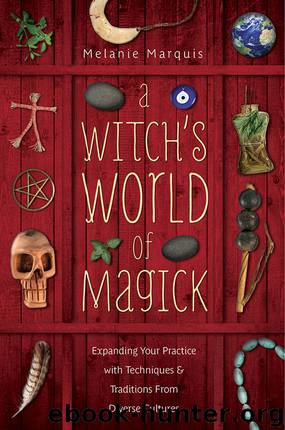A Witch's World of Magick by Melanie Marquis

Author:Melanie Marquis
Language: eng
Format: epub, azw3, pdf
Tags: world, world paganism, paganism, witch, wicca, witchcraft, melanie marquis, folk magic, world magic
Publisher: Llewellyn Worldwide, LTD.
Published: 2013-12-15T16:00:00+00:00
88. Samuel A. B. Mercer, trans., The Pyramid Texts (New York, London, Toronto: Longmans, Green, and Co., 1952), Utterance 534, accessed January 1, 2013, http://www.sacred-texts.com/egy/pyt/pyt29.htm.
89. Ancient Egypt Online, “Nephthys,” accessed March 13, 2013, http://ancientegyptonline.co.uk/nephthys.html.
Seven
Decoy Magick
The decoy principle is a magickal theory that can be effectively applied for cursebreaking, curse prevention, spell diversion, and spell recall. It’s the idea that a curse or other spell can be diverted away from its original target by using a decoy to create a distraction and take the heat of the magick. The decoy principle is particularly useful in its scope and versatility, as it can be employed to not only break active curses, but also to prevent them or divert them before the ill intentions have a chance to reach their target. In addition, the decoy principle can also be effectively applied in situations where a love spell or other less malicious but still unwanted magickal intention has been hurled your way. The decoy principle can even be used to affect our own magick, offering us a way to “call back” or otherwise divert spells we’ve cast before having a change of heart that makes the earlier magick undesirable or obsolete. In this chapter, we’ll examine some of the many ways the decoy principle has been applied in different cultures, different times, and different places, then we’ll see how these same ideas can be expanded to suit the modern witch.
Decoy Magick Around the World
One example of the decoy principle in action is probably already familiar to you; in fact, you might have such a decoy buried in your yard right now; its use still common in England, America, and elsewhere. The witch’s bottle is used to render protection through the means of diversion. Although construction methods vary, generally the object consists of a bottle or flask filled with a mixture of blood, urine, saliva, hair, nail clippings, rusty nails, pins, thorns, and other unsavory objects. The bottle is then buried or hidden in or near the home to draw off and absorb any curses or other ill intentions directed toward the house’s occupants.
More than two hundred witch’s bottles dating from the sixteenth and seventeenth centuries have been unearthed to date, with a majority of the bottles containing some combination of iron and human-derived materials such as urine, blood, hair, and fingernails. According to an article in Current Archeology, one witch’s bottle discovered in a ruined cottage just south of London was analyzed by a Dr. Alan Massey, and it was found to contain traces of urine, hair, and bent pins. The iron often incorporated in the bottles frequently takes the form of nails or pins that have been bent into an L-shape.90
Here, the human-derived ingredients provide the energetic similarity with the intended victim needed to make the bottle into a proper decoy that will attract the curse. The hair, urine, blood, or fingernails provide the energetic signature of the would-be victim, thereby creating a vibrational similarity that “tricks” the curse into entering the bottle rather than affecting the originally intended person.
Download
A Witch's World of Magick by Melanie Marquis.azw3
A Witch's World of Magick by Melanie Marquis.pdf
This site does not store any files on its server. We only index and link to content provided by other sites. Please contact the content providers to delete copyright contents if any and email us, we'll remove relevant links or contents immediately.
| Ancient & Controversial Knowledge | Ghosts & Hauntings |
| Hermetism & Rosicrucianism | Magic Studies |
| Occultism | Parapsychology |
| Supernatural | UFOs |
| Unexplained Mysteries |
Animal Frequency by Melissa Alvarez(4156)
Sigil Witchery by Laura Tempest Zakroff(4033)
Real Magic by Dean Radin PhD(3928)
Fingerprints of the Gods by Graham Hancock(3742)
Journeys Out of the Body by Robert Monroe(3466)
Aleister Crowley: The Biography by Tobias Churton(3429)
The Rosicrucians by Christopher McIntosh(3373)
Alchemy and Alchemists by C. J. S. Thompson(3299)
Mysteries by Colin Wilson(3255)
Hitler's Monsters by Eric Kurlander(3168)
The Hatha Yoga Pradipika (Translated) by Svatmarama(3078)
John Dee and the Empire of Angels by Jason Louv(3047)
Wicca: a guide for the solitary practitioner by Scott Cunningham(3045)
Infinite Energy Technologies by Finley Eversole(2834)
Dark Star Rising by Gary Lachman(2742)
The Book of Lies by Aleister Crowley(2727)
Book of Life by Deborah Harkness(2725)
Aliens by Jim Al-Khalili(2705)
To Light a Sacred Flame by Silver RavenWolf(2680)
